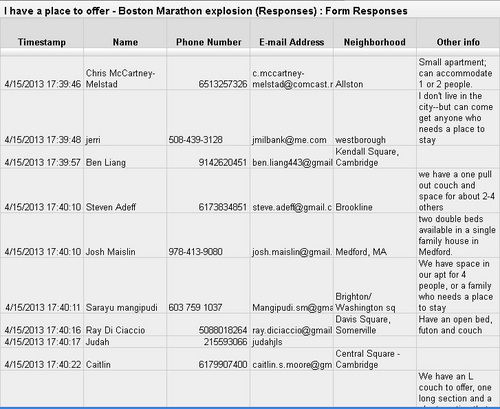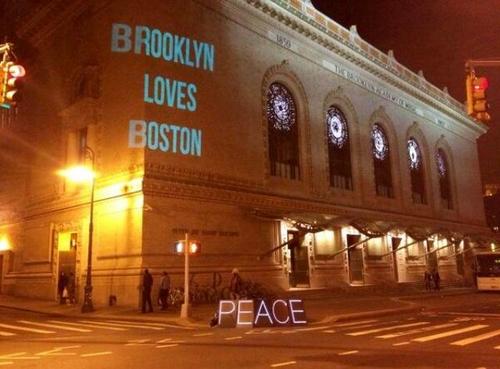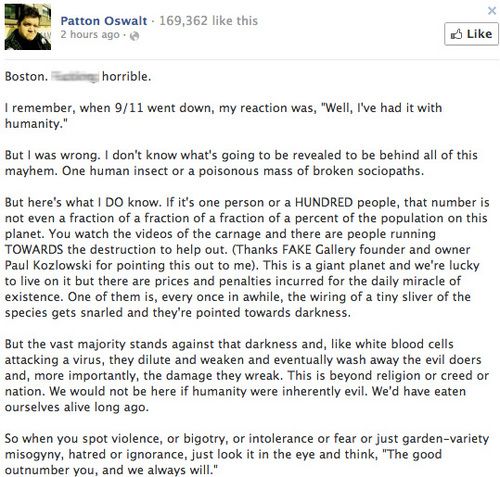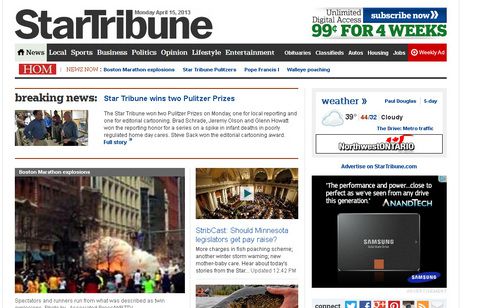Image takeaways from Boston, when journalists make a difference, the view from the wheelchair, the electric-shock bra, and when meteorologists fight.
There are, of course, any number of iconic images of yesterday’s bombing attack at the Boston Marathon. I’m choosing to go with this:
It’s a Google docs spreadsheet with pages and pages of email addresses and phone numbers from people offering a place for stranded marathon runners and their families to stay.
The accounts are not as compelling as some of the eyewitness reports to yesterday’s horror, but comforting nonetheless:
Myself and my roommate have a futon and a couch – we can fit up to three people. We can reimburse a cab/pay for a cab if you let us know you’re coming.
We are a gay couple, in case that might be a detriment or attribute to someone thought it would be important to know. We have a guest bedroom and a cat.
We will be in our apartment as well, but will happily give people our bed. We can fit 3 total. two in a full bed and 1 on the couch. 1584 tremont street, Boston.
And on it goes. People willingly giving up cell phone numbers, email addresses and private information, reminding us that we are a species that wants to help. The small acts and offers are often the only power we have, but it’s us doing the only things we know how to do: something. Anything.
” It’s not that Bostonians have something that makes them uniquely capable of dealing with this,” Charles Pierce writes today on Esquire. “It’s that people do.”
If we’re paramedics, we rush in where others are rushing out. If we’re reporters, we report. If we’re a thousand miles away, we tweet an encouraging word. If we’re artists in Brooklyn, we use our talent to create a viral image on the side of the Brooklyn Academy of Music that says what we always say when there’s not much else we can: “We love you. We thinking about you. Let us know if we can do anything.”
The sum of which tell us that we are better than we think we are.
But, of course, despite the reluctance of politicians and officials to say the “T” word, yesterday was an act of terror, even if it didn’t have — yet — some political or social “cause.” People are terrified and the danger of inflicting more damage by our response is high. That’s how terrorism works.
Don’t succumb to that, Bruce Schneier writes in The Atlantic.
If it’s hard for us to keep this in perspective, it will be even harder for our leaders. They’ll be afraid that by speaking honestly about the impossibility of attaining absolute security or the inevitability of terrorism — or that some American ideals are worth maintaining even in the face of adversity — they will be branded as “soft on terror.” And they’ll be afraid that Americans might vote them out of office. Perhaps they’re right, but where are the leaders who aren’t afraid? What has happened to “the only thing we have to fear is fear itself”?
Terrorism, even the terrorism of radical Islamists and right-wing extremists and lone actors all put together, is not an “existential threat” against our nation. Even the events of 9/11, as horrific as they were, didn’t do existential damage to our nation. Our society is more robust than it might seem from watching the news. We need to start acting that way.
“When we react from fear, when we change our laws and policies to make our country less open, the terrorists succeed, even if their attacks fail. But when we refuse to be terrorized, when we’re indomitable in the face of terror, the terrorists fail, even if their attacks succeed,” he writes.
In Boston, people fight back with spare futons.
Related:
Do journalists get a little too caught up in awards? The Pulitzer is about as prestigious an award as there is in the industry. Bigger than a terrorist attack?
Irrational exuberance aside, the Pulitzers are a reminder that great journalism requires journalists to take a stand. Too often, we prove our journalistic ethics by not taking sides and not championing some cause. But the Star Tribune knew that the number of children dying in child care had nearly doubled over five years was an unacceptable situation in a civilized state and, armed with facts, set about to make a difference.
And it did. State and county regulators stepped up enforcement and this year, only one child has died. And after last July through through the end of the year, none did.
Journalism isn’t stenography. It’s making a difference.
In the calm of a Tues. morn, we congratulate our @startribune friends for their Pulitzers. Esp. those not named. Good journalism takes many.
— Pioneer Press (@PioneerPress) April 16, 2013
3) THE VIEW FROM THE WHEELCHAIR
Minnesota Viking Chris Kluwe spent a day in a wheelchair to support efforts at the Legislature for a $4 million appropriation for research to discover a cure for paralysis. (h/t: Ben Chorn)
Chris Kluwe Rolls a Mile in Someone Else’s Wheels from Matthew Rodreick on Vimeo.
In many ways, I suppose, this next story is a perfect example of what I mentioned earlier — people doing what they can. In India the rape of a 23-year-old student in Delhi in December, 2012, focused new attention on the treatment of women in the country.
Manisha Mohan, an aeronautical engineering student at SRM University in the Indian city of Chennai, fellow students Niladhri Basu Bal and Rimpi Tripathi, decided to use their technical skills to try and do something to help protect women like her, the BBC reports.
They’ve developed a bra designed to deliver a 3800 kilovolt electric shock to any would-be rapist. It also sends a text message to a relative or friend and the local police station, with the GPS coordinates of the victim’s location.
(h/t: Mary Turck)
It can get a tad uncomfortable on Twitter when two local meteorologists have a spat. It happened this morning, and started with a tweet from a KSTP meteorologist and a response from a competitor at WCCO.
@pathammer No it’s not
— Mike Augustyniak (@MorningWXGuy) April 16, 2013
Was that an answer to the question Pablo Cruise is the best band ever?RT @morningwxguy: @pathammer No it’s not
— Patrick Hammer (@pathammer) April 16, 2013
@pathammer No; your snowfall stat. Average is 56″, not 46
— Mike Augustyniak (@MorningWXGuy) April 16, 2013
We use 125 year ave of 46″…56″ is 30 year average which was elevated due to heavy snow years in 80s RT @morningwxguy:No it’s not
— Patrick Hammer (@pathammer) April 16, 2013
@pathammer OK; that’s absolutely ridiculous. I’ll not drag you down in this… but that’s completely irrelevant and irresponsible
— Mike Augustyniak (@MorningWXGuy) April 16, 2013
But accurate. With a masters. And a kind heart. RT @pathammer: That am weather dude at WCCO is a little piss ant!! D jerridsebesta
— Mike Augustyniak (@MorningWXGuy) April 16, 2013
@pathammer The WMO requires averages be recalculated at least every 30 yrs; a WORLD standard. So, you’re basically ignoring the entire world
— Mike Augustyniak (@MorningWXGuy) April 16, 2013
@pathammer LOL. It might be inconvenient, but that snow actually happened. It deserves to be included.
— Mike Augustyniak (@MorningWXGuy) April 16, 2013
@pathammer Your incorrigable. Or your party line is.I can’t decide which it is.Bye for now, Patrick 🙂 Have a nice day.
— Mike Augustyniak (@MorningWXGuy) April 16, 2013
They eventually made up.
TODAY’S QUESTION
The Supreme Court is hearing arguments in a case that could stop the patenting of human genes. Advocates for the biomedical industry assert that patents drive medical discoveries. The multi-billion-dollar industry performs critical research in the fight against cancer and other diseases.
Opponents of gene patents, including Nobel Prize-winning scientists and medical groups say the patents slow discovery and research by restricting access to the genes. “Finding a new use for a product of nature, if you don’t change the product of nature, is not patentable,” lawyer Christopher Hansen argued.
Today’s Question: Should patents be allowed for human genes?
WHAT WE’RE DOING
Daily Circuit (9-12 p.m.) – First hour: America’s shrinking workforce.
Second hour: The latest research on empathy.
Third hour: Author Dennis Lehane talks about his love for Boston, his blue-collar background and his latest novel, Live by Night, which follows outlaw Joe Coughlin as he climbs the ranks of organized crime in prohibition-era America.
MPR News Presents (12-1 pm): Civil rights lawyer Michelle Alexander on “The New Jim Crow: Mass Incarceration in the Age of Colorblindness.”
Talk of the Nation (1-2 p.m.) – The Boston bombings.
All Things Considered (3-6:30 p.m.) – In an unlikely collaboration, actor Mark Rylance joined forces with Duluth poet Louis Jenkins to create a new play about ice fishing at the Guthrie. MPR’s Euan Kerr reviews.




